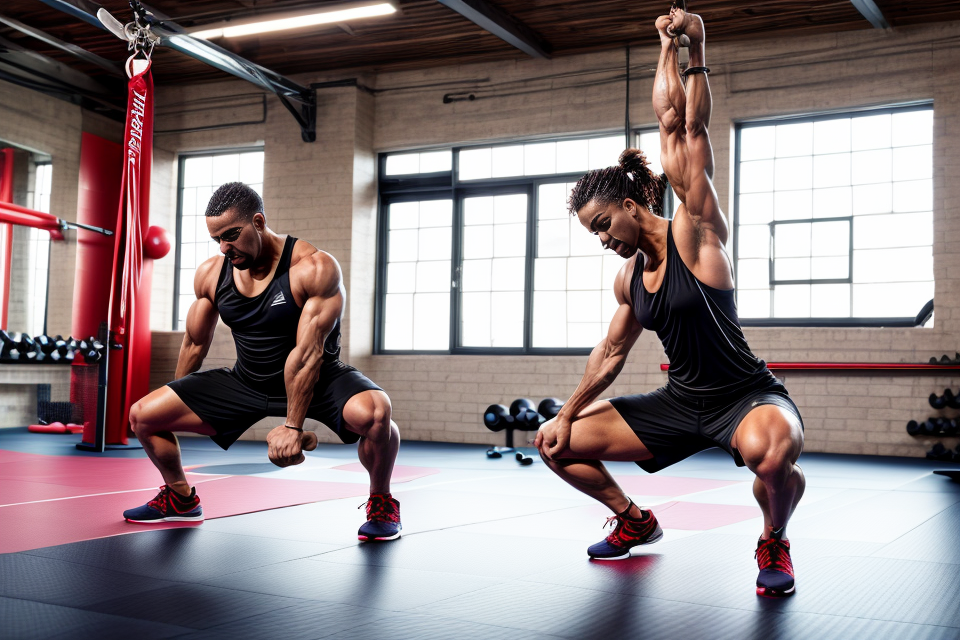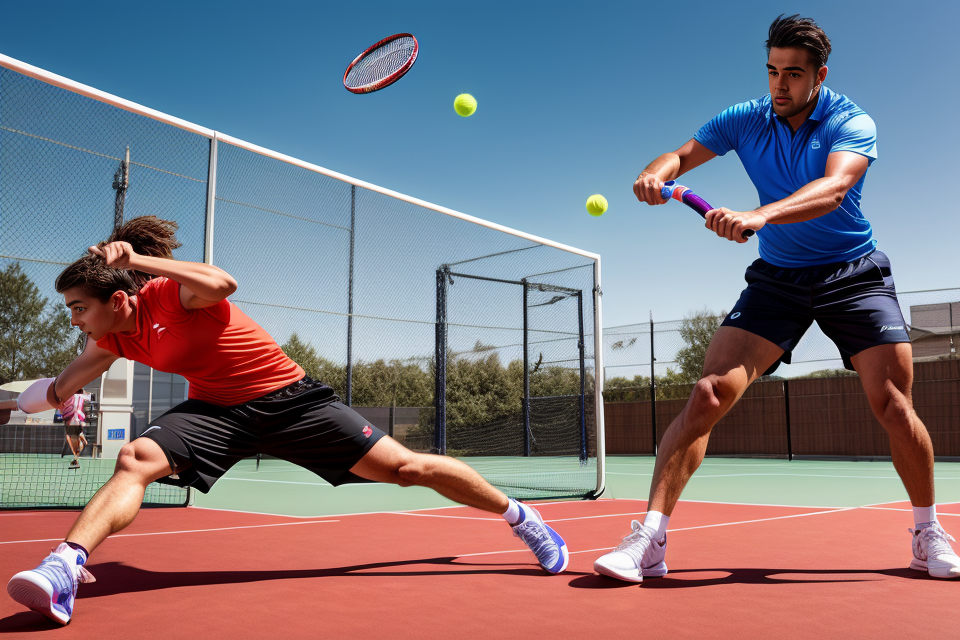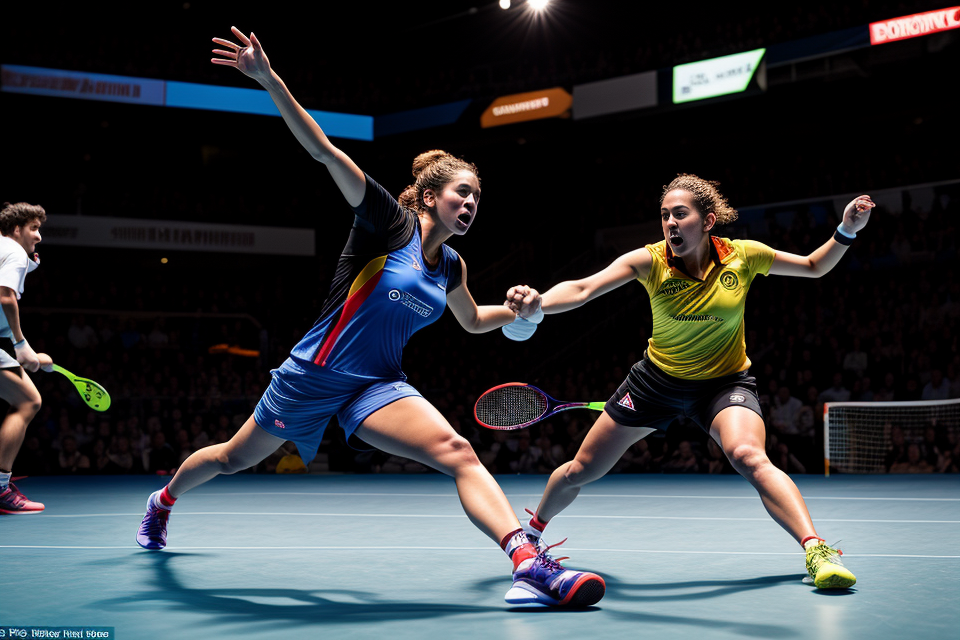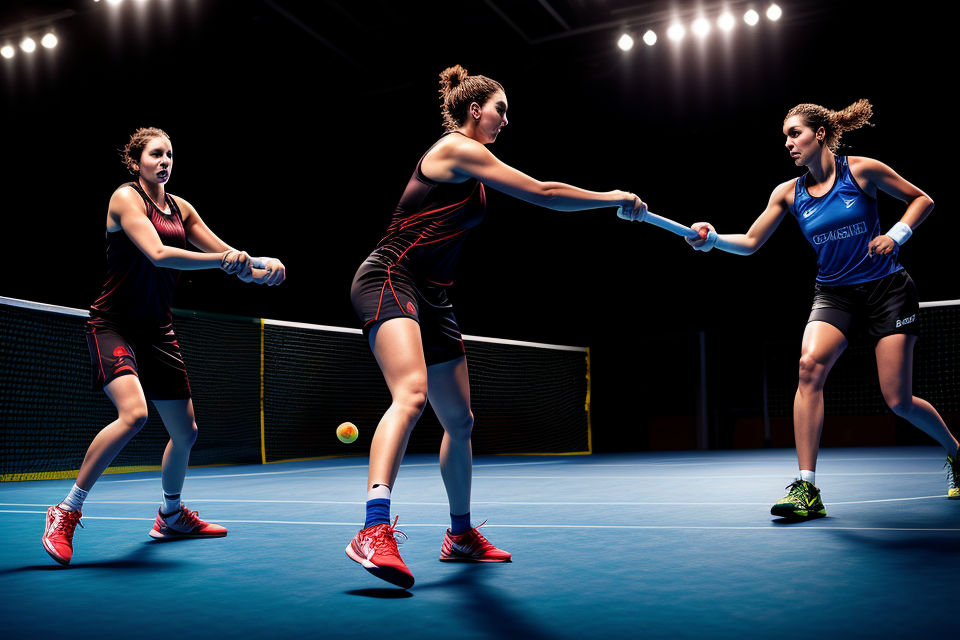Squash is a physically demanding sport that requires a combination of strength, endurance, and agility. To achieve top performance on the court, elite squash players undergo rigorous training regimens that focus on developing these physical attributes. This article will explore the various aspects of squash training, including strength and conditioning, technical skills, and mental preparation. We will also delve into the different training methods used by elite players to optimize their performance on the court. Whether you’re a beginner or an experienced player, this article will provide valuable insights into the world of squash training and help you take your game to the next level.
Elite squash players typically train by focusing on a combination of physical and mental skills. They often spend several hours each day practicing on the court, working on their footwork, technique, and endurance. They also engage in strength and conditioning exercises to improve their physical fitness and prevent injuries. In addition to physical training, elite squash players also prioritize mental preparation, including visualization techniques, mindfulness practices, and strategic planning to help them stay focused and perform at their best under pressure. They may also work with coaches and sports psychologists to refine their mental game and develop a winning mindset. Overall, elite squash players dedicate significant time and effort to training both physically and mentally in order to achieve top performance on the court.
Physical Conditioning
Cardiovascular Training
- Aerobic exercises: Elite squash players engage in high-intensity aerobic exercises such as interval training and steady-state cardio to improve their cardiovascular endurance. This type of training helps them to maintain a high level of energy throughout the game and reduces the risk of fatigue.
- Interval training: Interval training involves alternating between high-intensity and low-intensity exercises. Elite squash players use this method to improve their cardiovascular fitness, build endurance, and increase their ability to perform at a high level during match play.
- Anaerobic exercises: Squash is a sport that requires both aerobic and anaerobic fitness. Elite players incorporate anaerobic exercises such as plyometrics and high-intensity interval training into their training regimen to improve their explosiveness and power on the court.
Strength Training
- Resistance training: Elite squash players engage in resistance training to build strength and power in their muscles. This includes exercises such as weightlifting, resistance band training, and bodyweight exercises like push-ups and squats. Resistance training helps to improve muscular endurance, increase power, and reduce the risk of injury.
- Weightlifting: Weightlifting is an essential part of the training regimen for elite squash players. It helps to build strength and power in the legs, core, and upper body, which are crucial for success on the squash court. Weightlifting also helps to improve balance, coordination, and stability.
- Bodyweight exercises: Bodyweight exercises such as burpees, lunges, and planks are also incorporated into the training regimen of elite squash players. These exercises help to build strength and endurance in the muscles used during squash matches, including the legs, core, and upper body.
Flexibility and Mobility Training
- Stretching: Elite squash players engage in regular stretching to improve their flexibility and mobility. This helps to prevent injury and improve range of motion in the joints, which is essential for quick movements and agility on the court.
- Yoga: Yoga is a popular form of flexibility and mobility training for elite squash players. It helps to improve flexibility, balance, and stability, while also reducing stress and promoting relaxation.
- Pilates: Pilates is another form of flexibility and mobility training that is commonly used by elite squash players. It focuses on strengthening the core muscles and improving posture, which is essential for maintaining proper form and reducing the risk of injury on the court.
Technical Skills Development
Footwork and Movement
Elite squash players devote significant time to honing their footwork and movement skills. They understand that efficient footwork is essential for maintaining balance, gaining momentum, and executing shots effectively. Here are some agility drills, shuffle drills, and lunges that they incorporate into their training:
- Agility Drills: These drills focus on improving speed, quickness, and change of direction. Examples include shuffle drills, where players move laterally across the court, and ladder drills, which involve running up and down a ladder placed on the court.
* Shuffle Drills: Shuffle drills help players develop their ability to move quickly and change direction while maintaining balance and control. They practice shuffling in different directions, such as forwards, backwards, and sideways, and incorporate different footwork patterns into their movements. - Lunges: Lunges are an excellent exercise for developing leg strength, balance, and power. Players perform lunges by taking large strides with one leg while keeping the other leg bent and close to the body. This helps them build endurance and explosiveness in their legs, which is crucial for moving around the court efficiently.
Strokes and Shots
To become top-performing squash players, athletes must master various strokes and shots. These include forehand, backhand, volley, and drop shot. Here’s how elite players develop their technical skills in each of these areas:
- Forehand: The forehand is a crucial shot in squash, and elite players spend a lot of time perfecting it. They practice hitting the ball with a full swing of their arm, ensuring proper form and technique. They also work on driving the ball with power and accuracy, aiming for the front and center of the opponent’s court.
- Backhand: The backhand is another essential shot in squash, and top players devote considerable time to developing their backhand skills. They practice hitting the ball with a smooth, controlled motion, focusing on their wrists, arms, and shoulders. They also work on driving the ball with power and accuracy, aiming for the front and center of the opponent’s court.
- Volley: The volley is a shot used when the ball is played above the player’s knee height, and elite players spend time practicing this skill. They focus on their hand-eye coordination, timing, and proper technique, ensuring they can hit the ball with precision and control.
- Drop shot: The drop shot is a deceptive shot used to catch the opponent off guard. Top players practice hitting the ball with a low trajectory, making it drop quickly and bounce unpredictably on the court. They work on mastering the right amount of spin and speed to control the ball’s movement and catch their opponent off guard.
Tactics and Strategy
In addition to technical skills, elite squash players also invest time in developing their tactical and strategic abilities. They understand that winning matches requires more than just having excellent technical skills. Here are some of the tactics and strategies they focus on:
- Court positioning: Top players are skilled at positioning themselves on the court to be in the best possible position to receive the ball. They practice moving around the court efficiently, using the walls and corners to their advantage, and positioning themselves to be able to hit the ball with power and accuracy.
- Match analysis: Elite players analyze their matches to identify areas for improvement. They review their own performance and their opponents’ tactics, looking for ways to improve their own game and exploit their opponents’ weaknesses.
- Opponent profiling: Top players understand that each opponent has different strengths and weaknesses. They research their opponents’ playing styles,
Mental Game
Focus and Concentration
In order to achieve top performance in squash, elite players must possess an exceptional ability to focus and concentrate during matches. This mental skill is essential for success in a sport that requires split-second decision-making and lightning-fast reflexes.
- Meditation: Many elite squash players incorporate meditation into their training regimen to improve their focus and concentration. By practicing mindfulness meditation, players can learn to quiet their minds and eliminate distractions, which can help them maintain their focus during matches.
- Visualization: Visualization is another powerful tool that elite squash players use to enhance their focus and concentration. By mentally rehearsing their shots and strategies, players can develop a sense of confidence and control that can help them perform at their best.
- Breathing exercises: Proper breathing is crucial for maintaining focus and concentration during high-pressure situations. Elite squash players often practice deep, controlled breathing exercises to help them stay calm and focused under pressure.
Resilience and Mental Toughness
Achieving top performance in squash requires more than just physical skill. Elite players must also possess the mental toughness to bounce back from setbacks and maintain their focus and concentration under pressure.
- Positive self-talk: Positive self-talk is a key component of mental toughness. Elite squash players use positive affirmations to help them stay motivated and confident, even when faced with challenges or setbacks.
- Goal setting: Setting clear, achievable goals is essential for maintaining motivation and focus. Elite squash players often set short-term and long-term goals to help them stay on track and motivated.
- Mental rehearsal: Mental rehearsal involves visualizing success and mentally preparing for potential challenges. Elite squash players often use mental rehearsal to help them stay focused and confident during matches.
Overall, developing a strong mental game is crucial for elite squash players. By focusing on their ability to concentrate, maintain resilience, and stay mentally tough, players can improve their performance and achieve top results.
Nutrition and Recovery
Proper Nutrition
Elite squash players understand the importance of proper nutrition in achieving top performance. They focus on maintaining a balanced diet that provides them with the necessary nutrients for optimal physical and mental performance. Hydration is also a critical aspect of proper nutrition, and players ensure they stay well-hydrated before, during, and after training sessions.
To maintain high energy levels throughout their training, elite squash players consume energy-boosting foods such as complex carbohydrates, lean proteins, and healthy fats. They also pay attention to the timing of their meals, ensuring they eat sufficient amounts of protein and carbohydrates post-workout to support muscle recovery and glycogen replenishment.
Recovery Techniques
In addition to proper nutrition, recovery techniques play a crucial role in helping elite squash players achieve top performance. Rest and sleep are essential for physical and mental recovery, and players prioritize getting adequate rest between training sessions and matches.
Massage therapy is also a popular recovery technique among elite squash players. It helps to reduce muscle soreness, improve circulation, and promote relaxation. Foam rolling is another popular technique used by players to release muscle tension, improve flexibility, and reduce the risk of injury.
Overall, elite squash players understand that proper nutrition and recovery techniques are essential for maintaining peak physical and mental performance. By prioritizing these aspects of their training, they are able to train at high intensities and recover quickly, allowing them to perform at their best on the court.
Injury Prevention and Management
Warm-up and Cool-down
Elite squash players understand the importance of injury prevention and management, which is a crucial aspect of their training regimen. They incorporate specific warm-up and cool-down exercises to prepare their bodies for intense physical activity and to minimize the risk of injury.
Dynamic stretching
Dynamic stretching is a form of stretching that involves active movements, such as leg swings, arm circles, and hip openers. This type of stretching helps to increase blood flow, mobilize joints, and improve flexibility, which are essential for preventing injuries and enhancing performance.
Joint mobility exercises
Joint mobility exercises are designed to improve the range of motion in the joints, which can help prevent injuries and improve overall performance. These exercises may include movements such as ankle circles, shoulder rotations, and hip flexor stretches, which are tailored to the specific needs of the individual player.
Flexibility exercises
Flexibility exercises are an essential component of injury prevention and management for elite squash players. These exercises may include static stretches, such as hamstring stretches, calf stretches, and quad stretches, which help to improve flexibility and reduce the risk of injury.
Ergonomics and Equipment
In addition to warm-up and cool-down exercises, elite squash players also pay close attention to ergonomics and equipment to prevent injuries and enhance performance.
Proper grip and handle positioning
The grip and handle positioning of the squash racket are critical factors that can affect a player’s performance and risk of injury. Elite players often consult with coaches or sports specialists to determine the optimal grip and handle positioning for their individual playing style.
Footwear and footbeds
Footwear and footbeds are essential equipment for squash players, as they provide support and cushioning for the feet, which are crucial for preventing injuries and maintaining proper form during play. Elite players often invest in high-quality footwear and footbeds that are specifically designed for squash, which can help to improve their performance and reduce their risk of injury.
Eyewear and glasses
Eyewear and glasses are also important equipment for squash players, as they help to protect the eyes from impact and debris during play. Elite players often wear sports glasses or goggles that are designed specifically for squash, which can help to improve their vision and reduce their risk of eye injury.
Peak Performance Mindset
Growth Mindset
- Elite squash players often adopt a growth mindset, which is the belief that abilities and skills can be developed through dedication and hard work.
- This mindset allows players to embrace challenges and view setbacks as opportunities for growth, rather than as failures.
- Persistence and perseverance are key components of a growth mindset, as elite players understand that success often takes time and consistent effort.
- Continuous improvement is also a crucial aspect of a growth mindset, as players strive to identify areas for improvement and actively work to enhance their skills.
Positive Self-Talk
- Positive self-talk involves using encouraging thoughts and affirmations to boost motivation and confidence.
- Elite squash players may use positive self-talk to visualize success and maintain a positive attitude during training and competition.
- Research has shown that positive self-talk can improve performance and reduce stress, making it an important tool for elite athletes.
- It is important for players to use authentic and realistic positive self-talk, rather than unrealistic or exaggerated statements, in order to avoid negative consequences.
Mind-Body Connection
- The mind-body connection is an important aspect of peak performance in squash.
- Elite players often have a high level of body awareness, which allows them to control their movements and optimize their technique.
- Emotional intelligence is also crucial, as players must be able to manage their emotions and stay focused under pressure.
- Self-reflection and self-awareness are important for elite squash players, as they allow players to identify areas for improvement and make necessary changes to their training regimen.
FAQs
1. What types of training do elite squash players typically engage in?
Elite squash players typically engage in a combination of physical and mental training to achieve top performance. Physical training may include on-court drills, strength and conditioning exercises, and agility and speed work. Mental training may include visualization exercises, mindfulness practices, and strategy sessions with coaches.
2. How many hours per day or week do elite squash players typically train?
The amount of time elite squash players spend training can vary depending on their individual schedules and goals. However, it is not uncommon for them to train for several hours per day, and up to 30 hours per week or more leading up to a major tournament.
3. What types of drills do elite squash players practice on the court?
Elite squash players typically practice a variety of drills to improve their technical skills, footwork, and endurance. These may include basic skills drills such as hitting and volleying, as well as more advanced drills that focus on specific aspects of the game such as shot selection and movement.
4. How important is physical fitness for elite squash players?
Physical fitness is crucial for elite squash players, as it allows them to perform at a high level over the course of a match or tournament. In addition to cardiovascular endurance, players may focus on building strength and power in their legs, arms, and core to improve their shots and overall athleticism.
5. How do elite squash players manage injury prevention and recovery?
Injury prevention and recovery is an important aspect of elite squash players’ training regimens. This may include stretching and mobility exercises, foam rolling, massage, and other forms of physical therapy. Players may also work with coaches and sports medicine professionals to develop personalized injury prevention and recovery plans.










